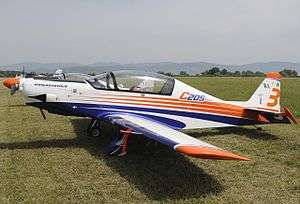New Avio C205
The New Avio C205 is an aerobatic ultralight aircraft, seating two in tandem and produced by New Avio, Gruppo NewCar of Italy.
| C205 | |
|---|---|
 | |
| Role | Two seat ultralight aircraft |
| National origin | Italy |
| Manufacturer | New Avio, Gruppo NewCar, Trevi |
| Status | Lits in production |
Design and development
The C205 is a low wing, single engine aircraft with a retractable conventional undercarriage. It has a wooden structure with a mixture of wood and carbon composite skinning. The low, trapezoidal wings, built around two spars, are entirely wooden apart from Kevlar reinforced leading edges. They have Hoerner-type tips; the trailing edge carries ailerons and electrically driven flaps. The main undercarriage legs are attached to the main spar and have a track of 2.23 m (7 ft 4 in).[1] The main gear is retracted hydroelectrically; the tailwheel is fixed.
The fuselage has a wooden structure, reinforced with steel plates and roll-bar, and tapers to the rear. The fin and rudder are straight edged, tapered and swept; the rudder and elevators are all horn balanced. A long, single piece canopy covers both seats, with a separate windscreen. Ahead, the engine is under a polycarbonate cowling: the standard power plant is a 60 kW (80 hp) Rotax 912 UL flat four, driving a variable-pitch propeller with a choice of two or three blades.[1]
The C205 can be built from kits, with two levels of pre-completion.[1]
Operational history
By mid-2010 there were at least four C205s on the European registers, all Italian.[2] Three of these have been used by the aeroclub at Trevi, where New Avio is based. They have been flown by the three-man Walter's Bad aerobatic team.[1]
Variants
- C205
- Original model
- C205 Evo
- Flying by 2007
Specifications (Evo)
Data from Jane's All the World's Aircraft 2010/11[1]
General characteristics
- Capacity: 2
- Length: 7.10 m (23 ft 4 in)
- Wingspan: 8.30 m (27 ft 3 in)
- Height: 1.78 m (5 ft 10 in)
- Powerplant: 1 × Rotax 912 ULS 4-cylinder horizontally opposed, 73.5 kW (98.6 hp)
- Propellers: 2-bladed (3-blade option)
Performance
- Maximum speed: 260 km/h (160 mph, 140 kn)
- Cruise speed: 230 km/h (140 mph, 120 kn)
- Stall speed: 65 km/h (40 mph, 35 kn) flaps down
- Never exceed speed: 350 km/h (220 mph, 190 kn)
- Endurance: 5.5 h
- g limits: +6/-6
References
| Wikimedia Commons has media related to New Avio C205. |
- Jackson, Paul (2010). Jane's All the World's Aircraft 2010-11. Coulsdon, Surrey: IHS Jane's. pp. 398–9. ISBN 978-0-7106-2916-6.
- Partington, Dave (2010). European registers handbook 2010. Air Britain (Historians) Ltd. ISBN 978-0-85130-425-0.